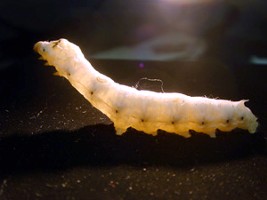A joint R&D project by University of Notre Dame in South Bend, Indiana, University of Wyoming in Laramie, and Kraig Biocraft Laboratories Inc. in Lansing, Michigan has succeeded in producing transgenic (genetically engineered) silkworms capable of spinning artificial spider silks.
Natural spider silks have a number of unusual physical properties, including higher tensile strength and elasticity than naturally spun silkworm fibers. The artificial spider silks produced in these transgenic silkworms, say the researchers, have similar properties of strength and flexibility to native spider silk.
Until this breakthrough, only very small quantities of artificial spider silk had been produced in laboratories, and there was no commercially viable way to produce and spin these artificial silk proteins. Kraig Biocraft believed these limitations could be overcome by using recombinant DNA to develop a bio-technological approach for the production of silk fibers with a much broader range of physical properties or with pre-determined properties.
The firm entered into a research agreement with Malcolm Fraser, a Notre Dame professor of biological sciences. Fraser discovered and patented a genetic engineering tool that can insert a piece of DNA known as a transposon into the genetic machinery of a cell. Fraser worked with University of Wyoming researcher Randy Lewis, a biochemist and authority on spider silk, and Don Jarvis, a molecular geneticist who specializes in insect protein production.
These transgenic silkworms spin their cocoons, not of ordinary silkworm silk, but a combination of silkworm silk and spider silk with improved elasticity and strength approaching that of native spider silk. Since silkworms already have a commercially viable silk production platform, these genetically engineered silkworms solve the problem of large-scale and economical production of engineered protein fibers.
Silk fibers have many current and possible future biomedical applications, such as use as fine suture materials, improved wound healing bandages, or natural scaffolds for tendon and ligament repair or replacement. Spider silk-like fibers could also be used in bulletproof vests, strong and lightweight structural fabrics, a new generation athletic clothing, and improved automobile airbags.


 RSS - Posts
RSS - Posts
You must be logged in to post a comment.